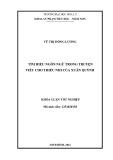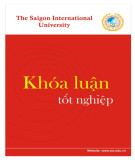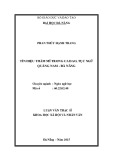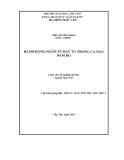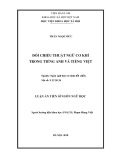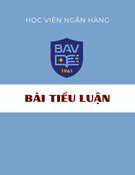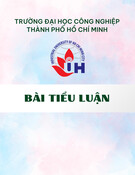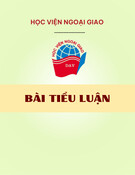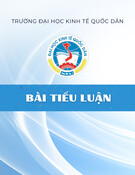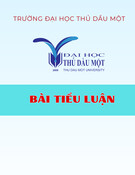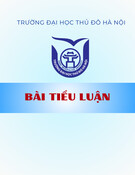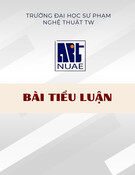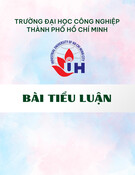
1
MINISTRY OF EDUCATION AND TRAINING
HANOI UNIVERSITY
English Department
Graduation Thesis
Strategies to deal with non-equivalence at
word level in translation
SUPERVISOR: Nguyen Ngoc Tan, M.A.
STUDENT: Pham Thanh Binh
CLASS: 11A-06
May 2010 - Hanoi

2
TABLE OF CONTENTS
CHAPTER ONE: INTRODUCTION……………………………………………. . 1
1.1. Background to the study……………………………………………………. ....... 1
1.2. Aims of the study……………………………………………………………. ...... 2
1.3. Scope and significance……………………………………………………….…. 2
1.4. Organization of the study………………………………………………………… 3
CHAPTER TWO: REVIEW OF THE LITERATURE……………………….... . 4
2.1. Introduction………………………………………………………………… ....... 4
2.2. Overview on translation equivalence …………………………………………… 4
2.2.1. The concept of equivalence………………………………………………..… 4
2.2.2. Different theories of equivalence…………………………………………… 5
2.2.2.1 Quantitative approach…………………………………………………. 5
2.2.2.2 Qualitative approach………………………………………………….. 5
2.2.2.2.1 Function-based equivalence……………………………………… 5
2.2.2.2.2 Meaning-based equivalence………………………………………. 6
2.2.2.2.3 Form-based of equivalence……………………………………..… 7
2.3 The problem of non-equivalence ………………………………………………… 7
2.3.1 Non-equivalence at word level…………………………………………….. 8
2.3.2 Recent studies on non-equivalence at word level ……………………. 10
CHAPTER THREE: THE STUDY………………………………………………. 12
3.1 Selected English – Vietnamese conceptual and lexical semantic
contrastive analysis……………………………………………………………… 12
3.1.1 Conceptual contrastive analysis……………………………………………... 12
3.1.1.1. Concept on kinship …………………………………………………… 12
3.1.1.2 Concept on color………………………………………………………. 14
3.1.1.3 Concept on temperature……………………………………………… 14
3.1.1.4 Concept from communication………………………………………… 15
3.1.2 Lexical semantic contrastive analysis………………………………….….. 16
3.1.2.1 Pronouns ……………………………………………………………… 16

3
3.1.2.2 Classifiers…………………………………………………………….. 19
3.1.2.3 Word Formation……………………………………………………….19
3.2. Classification of non-equivalence at word level …………………………………20
3.2.1. No equivalent words between 2 languages……………………………… 20
3.2.2. The source language concept is not lexicalized in the target language…. 24
3.2.3. The target language lacks a superordinate………………………………. 25
3.2.4. The target language lacks a specific term………………………………. 26
3.2.5 Differences in expressive meanings…………………………………….. 28
3.2.6 Differences in physical and interpersonal perspective………………….. 29
CHAPTER FOUR: SUGGESSTIONS AND CONCLUSION………………….. 30
4.1. Strategies to tackle non-equivalence at word level………………………. .......... 30
4.1.1 Translation by a more specific word (hyponym)………………………. 30
4.1.2 Translation by a more general word (superordinate) …………………… 32
4.1.3 Translation by a more neutral/less expressive word……………………. 33
4.1.4 Translation by cultural substitution…………………………………….. 35
4.1.5 Translation using a loan word or loan word plus explanation ……………37
4.1.6 Translation by paraphrasing…………………………………………….. 38
4.1.7 Translation by omission…………………………………………………. 41
4.1.8 Translation by illustration…………………………………… ................. 42
4.2. Conclusion……………………………………………………………… ............ 43
4.3 Suggested exercises …………………………………………………………… .. 45
REFERENCES …………………...…………………………………………………47

4
LIST OF TABLES
Table 1: Baker’s taxonomy of non-equivalence at word level (1992)……… 10
Table 2: Vietnamese personal pronouns (Thanh Ngo, 2006) ............................ … 16
Table 3: Addressing terms used among Vietnamese family members
(Duong, 1999) ……………………………………………………………. 17
Table 4: Kinship terms used in social interaction (Duong, 1999)………………… 18
Table 5: Selected categories and examples about Cultural Concepts…………….. 21
Table 6: Individualism Index Values among nations
(as adapted from Hofstede , 2000 ) ................................................... ……. 22
ABSTRACT

5
This study primarily investigates the problem of non-equivalence at word level in translation
between English and Vietnamese which is observed as the weakness of the majority of students
in English Department – Hanoi University.
The paper aims at, first and foremost, presenting rationale, background knowledge and
different approaches relate to non-equivalence before contrasting some typical conceptual and
lexical semantic fields to prove that there is a considerable linguistic gap between English and
Vietnamese. Then the study will propose a classification of non-equivalence based on Mona
Baker’s theory. Eventually, the study also suggests several effective strategies to deal with non-
equivalence at word level in translation.
ACKNOWLEDGEMENTS

